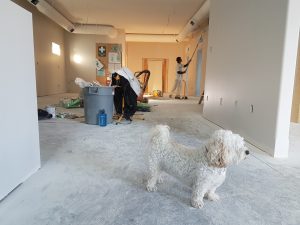Expand and brighten the rooms by painting the walls in pastel or soft yellow. Keep these points in mind to create a nice effect without falling into monotony.
 Do you have doubts about using the pastel yellow color in the painting of the walls or the decoration of your house? Do not worry. Now we will see some tips to help you avoid mistakes when using this soft and delicate hue in your home.
Do you have doubts about using the pastel yellow color in the painting of the walls or the decoration of your house? Do not worry. Now we will see some tips to help you avoid mistakes when using this soft and delicate hue in your home.
Why Pastel Yellow Is A Special Color
Let’s start by getting to know some of the qualities of yellows that make them special, mainly pastel or soft tones.
They have a good affinity with light. In the same way as the color white, yellow reflects light making the environment look bright. It is indicated for small rooms where you want to accentuate the light and details. You must take into account add all the light sources, natural or artificial, necessary to create this effect.
It is a very delicate color, and that characteristic radiates in the environment that uses it. This way, bedrooms or living rooms are created with a serene and delicate appearance, in the same way, that a pink, soft green, or pale lavender would.
It tends to dazzle with excess light if you want to use it in places where a lot of natural light enters. You will have to consider if you want to increase the luminosity in an environment where you stay long. Maybe you need something less clear and less aggressive for your eyes.
It can be simple or bland if it is not combined properly. It’s not just about painting pastel yellow and nothing else. It is always necessary to know what other shades to accompany it, in which places it will look better and in which it will not.
Where You Can Paint Soft Yellow
As I have already said several times in the notes of Pinto mi Casa, there are no special colors for particular environments. In this case, the yellows can be used wherever you want. But I can give you some suggestions:
 It is a good choice for a bathroom, a place where light and the appearance of spaciousness are appreciated. It is also suitable for other small spaces, such as the entrance, corridors, and laundry rooms.
It is a good choice for a bathroom, a place where light and the appearance of spaciousness are appreciated. It is also suitable for other small spaces, such as the entrance, corridors, and laundry rooms.
If the light doesn’t bother you in the morning, it is a good color for the bedroom as it creates a serene and delicate atmosphere.
It is suitable for the children’s room as long as it combines with other shades to create more dynamism and variety. Here it can be accompanied by other pastel shades of pink, mint green, light blue, or lavender.
It is a good alternative to common environments, such as the kitchen, living room, or dining room, as long as you combine it with white. You should continually try to play with contrasts and details to avoid falling into monotony.
And What Colors Should You Combine It With…
White: the neutral that should not be missing. It facilitates the dispersion of light and accentuates the coloring of soft tones.
Greys: the alternative to white. It creates a very nice contrast effect, also providing a modern touch.
Brown Or Brown: earth tones are perfect, as well as the natural shades of wood and other existing materials.
Blues (mint, turquoise, apple): Used to create contrasts in minor details.
Not all of us have the same tastes and the same needs. Maybe you want to use the color yellow to paint or decorate because it seems the right one. On the contrary, other people will discard it from their preferred color palette. Perhaps with these tips, the result will be more than pleasant.
